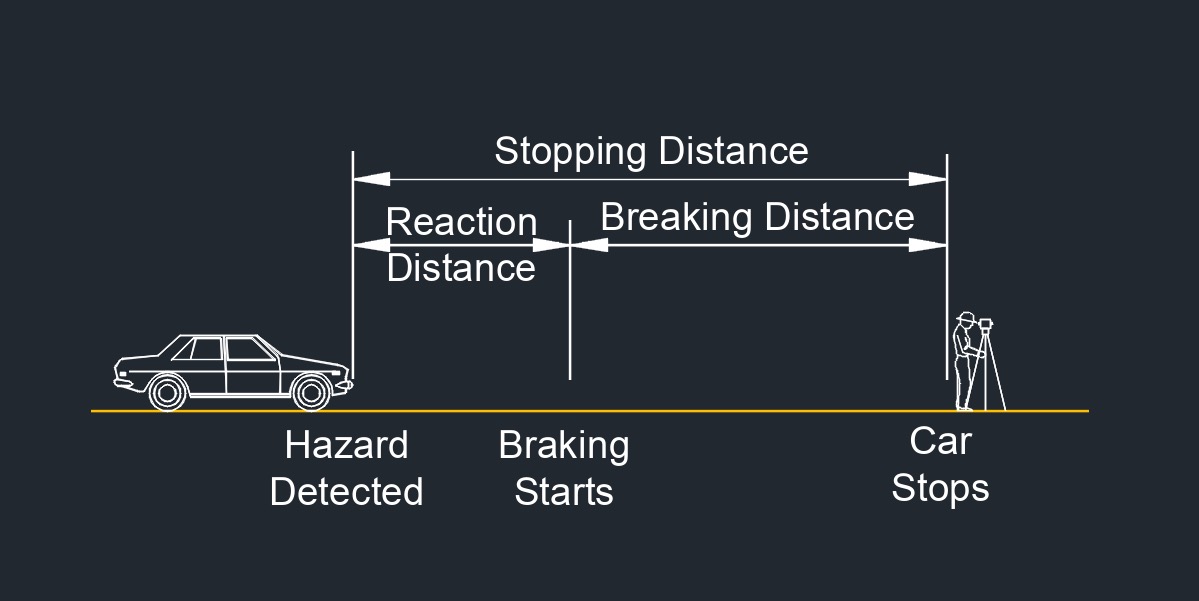Brake Reaction Distance
Brake reaction Distance Formula |
||
|
\( B_r \;=\; 1.47 \cdot V \cdot t \) (Brake Reaction Distance) \( V \;=\; \dfrac{ B_r }{ 1.47 \cdot t }\) \( t \;=\; \dfrac{ B_r }{ 1.47 \cdot V }\) |
||
| Symbol | English | Metric |
| \( B_r \) = Brake Reaction Distance | \(ft\) | \(m\) |
| \( V \) = Design Speed | \(ft \;/\; sec\) | \(m \;/\; s\) |
| \( t \) = Brake Reaction Time | \(mi\) | \(km\) |
Brake reaction distance, abbreviated as \(B_r\), is the distance traveled from the point of detecting a hazard until you begin braking.

Brake reaction distance, abbreviated as \(B_r\), also called reaction distance, is the distance a vehicle travels while a driver reacts to a perceived hazard and initiates the braking process. It is a crucial component of the overall stopping distance and plays a significant role in ensuring safe driving and collision avoidance. When a driver observes a hazard or an unexpected situation on the road, there is a delay between perceiving the danger and physically reacting by applying the brakes. This delay is known as the reaction time and is influenced by various factors, including the driver's alertness, visibility, cognitive processing, and physical coordination.
AASHTO Exhibit 3-1 Stopping Sight Distance
|
||||
| Design Speed |
Design Speed Distance |
Braking Distance on Level | Stopping Sight Distance | |
| Calculated | Design | |||
| 15 | 55.1 | 21.6 | 76.7 | 80 |
| 20 | 73..5 | 38.4 | 111.9 | 115 |
| 25 | 91.9 | 60.0 | 151.9 | 155 |
| 30 | 110.3 | 86.4 | 196.7 | 200 |
| 35 | 128.6 | 117.6 | 246.2 | 250 |
| 40 | 147.0 | 153.6 | 300.6 | 305 |
| 45 | 165.4 | 194.4 | 359.8 | 360 |
| 50 | 183.8 | 240.0 | 423.8 | 425 |
| 55 | 202.1 | 290.3 | 492.4 | 495 |
| 60 | 220.5 | 345.5 | 566.0 | 570 |
| 65 | 238.9 | 4.505 | 644.4 | 645 |
| 70 | 257.3 | 470.3 | 727.6 | 730 |
| 75 | 275.6 | 539.9 | 815.5 | 820 |
| 80 | 294.0 | 614.3 | 908.3 | 910 |
It's important to note that the brake reaction distance is the distance the vehicle travels during the time it takes the driver to initiate braking. The total stopping distance, on the other hand, includes both the brake reaction distance and the braking distance, which is the distance the vehicle travels while coming to a complete stop after the brakes have been applied.
To ensure safety, drivers are encouraged to maintain a safe following distance from the vehicle in front of them to account for reaction time and braking distance. Reaction time can vary based on individual factors and external conditions, so having a cushion of space helps mitigate the risk of rear-end collisions and provides sufficient time for the driver to respond effectively to changing road conditions.

